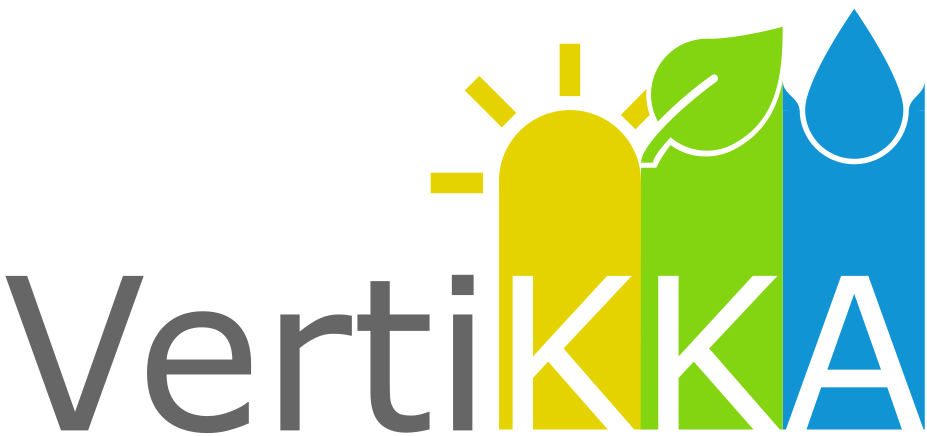FAQ
Frequently asked questions about VertiKKA
Here is a selection of frequently asked questions about VertiKKA. If you cannot find you question here, please use the contact form to get in touch with us.
Grey water is lightly polluted wastewater from bathrooms and washing machines. VertiKKA also uses wastewater from kitchens. Grey water accounts for about two-thirds of the total domestic wastewater volume. Special piping systems can collect grey water separately from faecal wastewater from toilets.
Pre-treatment of the grey water and the irrigation of the plants has been designed to ensure that there will be no odour problems for residents.
Our research strives to achieve the best possible water purification performance using VertiKKA modules. Depending on the degree of purification achieved and local minimum values required, the purified grey water can be drained into the soil, used for garden irrigation or toilet flushing after passing through VertiKKA modules. If the local minimum values cannot be achieved, the water must be discharged into the sewage sys-tem via the normal route.
As a user or resident of the building, you do not need to make any changes. VertiKKA regulates and irrigates itself automatically. On the contrary, you will notice that the building is cooler in sum-mer and you will have reduced heating require-ments in winter. The separate collection of grey and black water will not require you to make any changes in your everyday life; however, there will be slight, short-term limitations during the one-off structural adjustment to pipes. The wastewater flows will simply be kept separate. Our aim is that you can continue to use your usual detergents and cleaning agents without this having a negative effect on the cleaning performance of the plants.
In principle, all types of building are suitable for VertiKKA, as the modules are mounted on a separate frame on the façade of the building. How-ever, building-specific factors must be taken into account, such as large glass frontage, protruding façade elements, ventilation systems and any listed building status. Since the installation of VertiKKA modules also requires a certain amount of associated technology (such as measurement and control technology, grey water collection and treatment and inverters for the solar system), installation is only economically worthwhile on a given minimum façade area, which must be determined on a case-by-case basis.
A minimum distance is maintained between the modules and the wall. This ensures sufficient rear ventilation to counteract moisture on the façade. The modules are mounted on a frame to allow the number of contact points with the façade to be kept to a minimum. Excessive growth of the plants must be limited by regular maintenance. In addition, the modules protect the façade from the effects of the weather.
Due to the cooling effect of the green modules and improved thermal resistance, the energy requirement for cooling in summer and heating in winter can be reduced. However, actual energy savings are highly dependent on the type of wall construction and local conditions. VertiKKA modules are still in a research phase, so solid energy saving data has yet to be collected and evaluated.
Since treated grey water and rainwater is used for irrigating the modules, there is no additional water requirement. On the contrary: due to the separate wastewater collection, the treated grey water can also be used for other irrigation tasks, thus saving drinking water overall.
Greening influences the local micro-climate thanks to significant effects such as evapotranspiration, absorption and reflection of solar radi-ation, binding and filtering of dust and pollutants and CO2 assimilation. The larger the greened area, the greater the effects on the microclimate.
For pure plant modules, one to two maintenance visits per year are necessary. For the other components of the VertiKKA module, some practical experience will demonstrate how much maintenance is required. Costs can be reduced by combining this maintenance with other façade work, such as window cleaning.
The façade is structurally separate from the module and thus protected. The distance of the module from the façade is planned according to the plants’ physiological requirements and has the added benefit of protecting the façade. On the ground and depending on the choice of plants, the green modules do not generate more foliage than a similarly large tree. Good planning and regular maintenance can minimise soiling and leaf fall to a significant extent.
VertiKKA greening modules are primarily planted with evergreens so that they also fulfil their func-tion in winter and do not look "bare". The addition of deciduous plants creates contrast and reflects the change of the seasons.
Many cities already subsidise greening measures such as façade greening. Whether your VertiKKA project is eligible for funding must be checked on a case-by-case basis and depends on the funding measures in your city.

